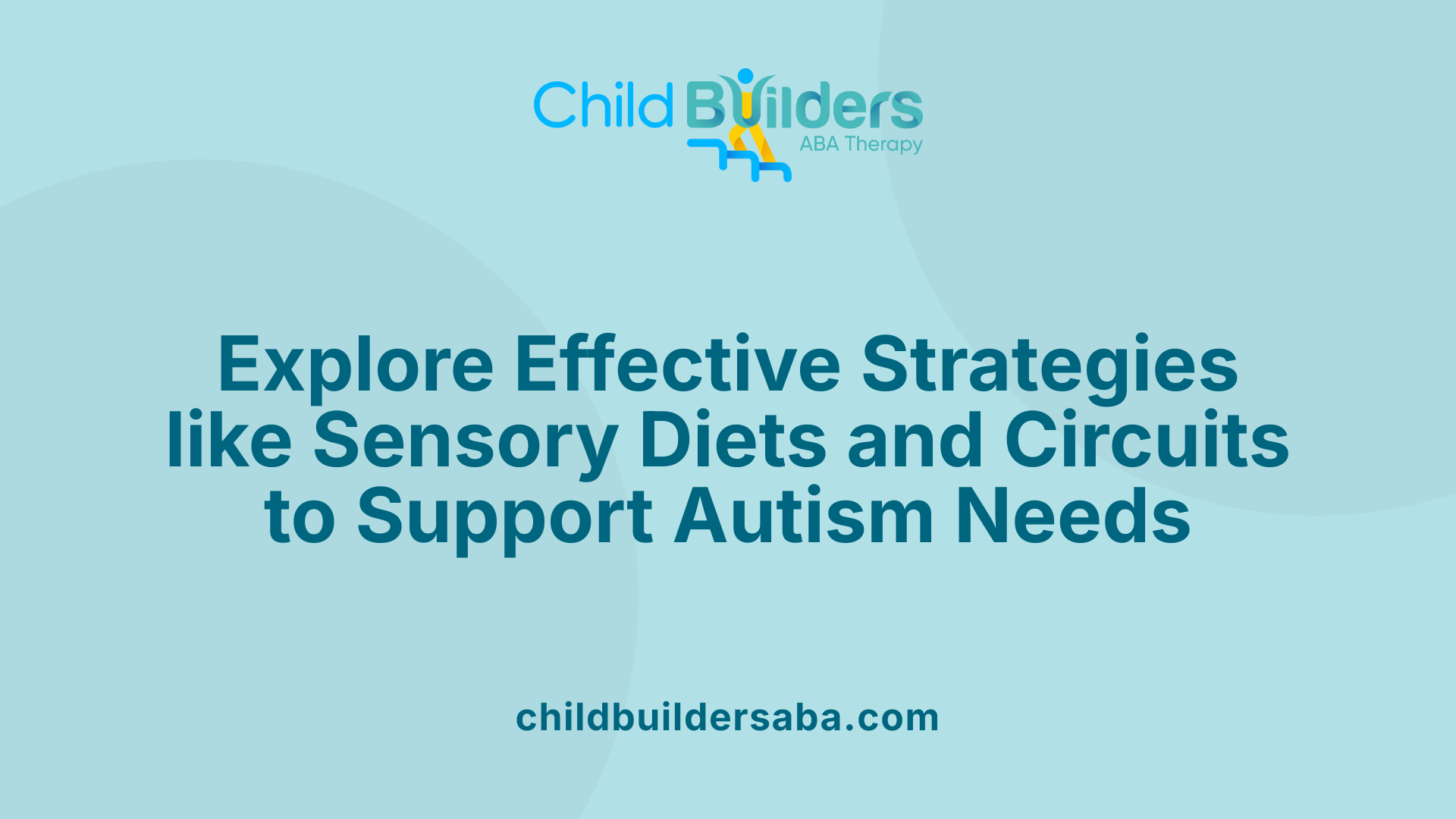What Is Occupational Therapy For Autism?

Understanding Occupational Therapy for Autism
Occupational therapy (OT) serves as a cornerstone in supporting individuals with autism spectrum disorder (ASD), focusing on enhancing daily functioning across various life domains. Through a blend of assessment, personalized strategies, and targeted interventions, OT aims to foster independence, improve social participation, and manage sensory sensitivities. This article explores what occupational therapy for autism entails, its benefits, the role of therapists, assessment techniques, intervention strategies—including sensory diets and circuits—and the skills targeted to improve quality of life for autistic individuals.
What Is Occupational Therapy for Autism and How Does It Work?

What is occupational therapy for autism and how does it work?
Occupational therapy (OT) for autism is a targeted form of treatment designed to help individuals develop essential skills for daily life. It focuses on improving abilities related to self-care, communication, social participation, and emotional regulation.
A licensed occupational therapist conducts a thorough assessment of each person’s sensory processing, motor skills, and behavioral patterns. This evaluation helps identify specific obstacles to participation in everyday activities. Based on these findings, the therapist creates a personalized treatment plan tailored to the individual's unique needs.
Interventions used in OT include sensory integration techniques, social skills training, and routines for self-care such as dressing and grooming. Therapists often incorporate playful, goal-driven activities and exercises that promote motor development and emotional well-being.
Techniques like sensory diets—structured daily activities that include calming or alerting sensory input—are commonly used to help regulate sensory sensitivities. Sensory circuits, which are quick, structured activities, help prepare children for learning by 'waking up' their senses.
The main aims of occupational therapy for autism are to enhance independence, improve participation in daily tasks, and foster stronger relationships and emotional control. Early therapy intervention is especially effective in supporting developmental progress and confidence, helping individuals manage sensory sensitivities and become active, engaged community members.
Overall, OT provides meaningful support to improve quality of life, turning everyday challenges into achievable goals—encouraging growth, resilience, and greater self-sufficiency.
Recognizing the Benefits of Occupational Therapy in Autism Support

What are the benefits of occupational therapy for individuals with autism?
Occupational therapy provides valuable support for people with autism across many areas of daily life. One of its main goals is to help develop essential self-care skills such as dressing, grooming, eating, and personal hygiene. By improving these abilities, individuals gain more independence and confidence in managing everyday tasks.
A significant focus of occupational therapy is addressing sensory processing differences. Many autistic individuals experience sensory overload or under-stimulation, which can impact their ability to focus and regulate emotions. Therapists utilize sensory diets—customized activity plans involving activities like swinging, listening to calming music, or walking—to help regulate sensory arousal levels. Sensory integration techniques, including the use of swings, foam mats, or therapy balls, are also employed to desensitize or enhance sensory processing, reducing anxiety and improving behavior.
Therapists work to boost communication and social skills through play-based activities and social participation exercises. This support can lead to better interaction with peers and family members, fostering meaningful relationships.
Occupational therapy also increases overall confidence and self-esteem. When children and adults learn to manage their sensory needs and develop new skills, they feel more capable and comfortable in various settings like home, school, and community environments.
In addition to skill development, therapy helps with emotional and behavioral regulation. Strategies such as cognitive-behavioral techniques or emotional regulation exercises assist individuals in managing anxiety, frustration, or behavioral challenges.
Overall, occupational therapy aims to improve quality of life for autistic individuals by enabling greater independence, smoother transitions between activities, and enhanced participation in daily routines and social activities. Tailored to each person’s strengths and needs, occupational therapy supports not just functional skills but also emotional well-being and social integration.
The Critical Role of Occupational Therapists in Autism Care

What is the role of occupational therapists in supporting autistic individuals?
Occupational therapists are essential in helping autistic individuals develop skills that improve their quality of life. They begin with thorough assessments of sensory processing, motor skills, social behaviors, and daily living activities. These evaluations help identify specific challenges and strengths unique to each person.
Using this information, occupational therapists create personalized treatment plans. They incorporate strategies such as sensory diets—daily activity plans with sensory activities tailored to the individual's needs—and sensory circuits, which are short, structured activities designed to stimulate or calm the senses at the start of the day.
OTs work across various environments including schools, homes, clinics, and community settings. They implement interventions that support independence in daily routines like dressing, feeding, grooming, and self-care. Through environmental modifications—like sensory rooms or adapted tools—they help individuals better manage sensory sensitivities and motor difficulties.
Collaboration is a key part of their work. Occupational therapists partner with families, caregivers, teachers, and other health professionals to ensure consistency and reinforcement of skills across all settings. They also guide caregivers by teaching strategies and exercises to support ongoing progress outside therapy sessions.
A fundamental aspect of occupational therapy is recognizing and building on each individual’s strengths. Promoting a positive autistic identity and respecting neurodiversity are central to therapy, fostering confidence and self-acceptance.
Overall, OTs help individuals with autism participate meaningfully in everyday activities, improve social and emotional skills, and navigate life transitions more effectively. Their holistic, person-centered approach ensures that therapy is tailored, effective, and supportive of each person's unique journey toward independence.
Assessment Techniques in Occupational Therapy for Autism
 Occupational therapy for autism employs a variety of assessment methods to understand each individual's unique needs and develop effective intervention plans. Standardized assessment tools are often used, including the Autism Diagnostic Observation Schedule (ADOS-2) and the Childhood Autism Rating Scale (CARS). These allow therapists to evaluate core areas such as social communication, sensory processing, and behavior patterns.
Occupational therapy for autism employs a variety of assessment methods to understand each individual's unique needs and develop effective intervention plans. Standardized assessment tools are often used, including the Autism Diagnostic Observation Schedule (ADOS-2) and the Childhood Autism Rating Scale (CARS). These allow therapists to evaluate core areas such as social communication, sensory processing, and behavior patterns.
In addition to formal testing, therapists conduct caregiver interviews and direct observations in different settings. These conversations and behavioral observations help gather essential information about the person’s strengths, challenges, and daily routines.
Developmental and sensory profiling are also important components of the evaluation. These profiles identify specific sensory sensitivities or processing differences that might affect participation in daily activities. Early screening tools like the Modified Checklist for Autism in Toddlers (M-CHAT) and Ages and Stages Questionnaires (ASQ) are used to identify children who may benefit from further assessment.
To monitor ongoing progress, therapists often use tools like the Autism Treatment Evaluation Checklist (ATEC). This helps track improvements over time and determine whether adjustment in strategies is needed.
The assessment process is comprehensive and tailored to each individual. It involves collecting detailed developmental, sensory, and behavioral data, which supports the creation of personalized goals. Regular evaluation ensures that therapy approaches remain aligned with the individual’s evolving needs, ultimately enhancing their daily functioning and independence.
Summary of Assessment Methods in Occupational Therapy for Autism:
| Assessment Tool/Method | Purpose | Additional Details |
|---|---|---|
| ADOS-2 | Diagnosis and assessment of social and communication skills | Standardized observational assessment |
| CARS | Evaluates severity of autism symptoms | Provides rating across different domains |
| Caregiver Interviews | Gather detailed personal and environmental information | Involves family input on routines and behaviors |
| Developmental Checklists | Identify developmental delays | Used early for screening |
| Sensory Profiles | Assess sensory processing difficulties | Guides sensory-based interventions |
| ATEC | Monitor progress over time | Re-administer periodically |
| M-CHAT, ASQ | Early detection screening | Mainly for young children |
These assessments form a comprehensive picture, enabling tailored, effective therapy strategies for children and adults on the autism spectrum.
Intervention Strategies: Sensory Diets, Sensory Circuits, and More
 Occupational therapy (OT) for autism utilizes a range of targeted intervention strategies to address sensory, motor, social, and behavioral challenges. Two prominent approaches are sensory diets and sensory circuits, designed to help individuals process sensory information more effectively.
Occupational therapy (OT) for autism utilizes a range of targeted intervention strategies to address sensory, motor, social, and behavioral challenges. Two prominent approaches are sensory diets and sensory circuits, designed to help individuals process sensory information more effectively.
Sensory diets are personalized plans that include specific activities to regulate arousal and improve focus throughout the day. These activities might involve swinging, playing with textured materials, listening to calming music, or engaging in movement exercises such as jumping or stretching. The goal of a sensory diet is to provide the brain with the sensory input it needs to remain calm and alert, enabling better engagement in daily activities.
Sensory circuits are structured routines of short sensory-motor activities performed at the start of the day or in between tasks. They are designed to 'wake up' the senses—using tools like foam rollers, trampolines, or vibrating toys—to prepare children for learning and participation. These circuits help children reach a state of readiness, boosting concentration, emotional regulation, and overall participation.
Aside from sensory-based interventions, occupational therapy also employs social skills training, modeled behaviors, and peer participation activities. These are aimed at enhancing communication, emotional regulation, and social interactions, which are often areas of difficulty for children with autism.
In addition, the use of assistive technology and visual supports plays a significant role. Visual schedules, social stories, and role-playing help children understand routines, expectations, and social cues. These tools facilitate independence and reduce anxiety during transitions and new experiences.
Overall, OT strategies in autism are highly individualized and flexible, focusing on improving everyday skills and quality of life. They combine sensory integration techniques with behavioral and social skills interventions, supported by assistive tools to help individuals achieve greater independence and integration in their daily environments.
Skills Targeted in Occupational Therapy for Autism
Which skills are targeted in occupational therapy for autism?
Occupational therapy for children with autism aims to improve a wide variety of essential skills to boost independence and overall well-being. These skills include sensory processing and regulation, fine and gross motor skills, self-care routines, social interactions, and emotional control.
Therapists employ different strategies to meet each child's specific needs. Sensory diets and sensory integration therapies are used to help children manage sensory sensitivities and avoid overload or under-stimulation. Play-based and activity-oriented approaches focus on developing motor skills like handwriting, dressing, and using utensils.
In the social and communication domain, therapies often include social skills training and activities that promote better interaction with peers and adults. Emotional regulation techniques are also incorporated to help children manage behaviors linked to anxiety and sensory overload.
Overall, occupational therapy endeavors to foster independence in daily activities—such as self-care tasks like brushing teeth or grooming—and to strengthen skills in social engagement.
This comprehensive approach supports children in better understanding and navigating their environments, reducing behavioral challenges, and improving their participation in everyday life. The intervention plans are tailored to each child's unique profile, incorporating sensory processing, motor development, communication, and emotional regulation to empower them for greater autonomy and improved quality of life.
Below is a quick overview of the areas targeted:
| Skill Area | Focus | Typical Strategies |
|---|---|---|
| Sensory processing | Regulating responses to sight, sound, touch, etc. | Sensory diets, sensory integration therapy |
| Motor skills | Improving coordination for daily tasks | Fine and gross motor activities, play therapy |
| Self-care routines | Building independence in dressing, eating, grooming | Activity-based training, visual supports |
| Social skills | Enhancing communication and peer interaction | Social stories, role-playing |
| Emotional regulation | Managing emotions and behaviors | Relaxation techniques, behavior strategies |
This holistic focus helps children achieve greater personal independence and integration into their social and physical environments.
Empowering Independence in Daily Life
Occupational therapy plays a pivotal role in supporting individuals with autism by developing essential life skills, promoting independence, and enhancing participation in everyday activities. Through comprehensive assessments and personalized interventions, OTs address sensory, motor, social, and emotional challenges, enabling autistic individuals to lead more fulfilling lives. The benefits are profound and far-reaching, making OT an indispensable part of autism care that fosters growth, confidence, and inclusion.
References
- Occupational therapy - Autism Speaks
- Why is occupational therapy important for autistic children?
- A Guide to Occupational Therapy for Autism | USAHS
- [PDF] Occupational Therapy and Autism Spectrum Disorder
- How Occupational Therapy Can Help Children with Autism
- Evaluating the Benefits of Occupational Therapy in Children With ...
- Occupational Therapy Treatment for Autism - Surrey Place
- Occupational Therapy | Kinark Autism Services





































































































